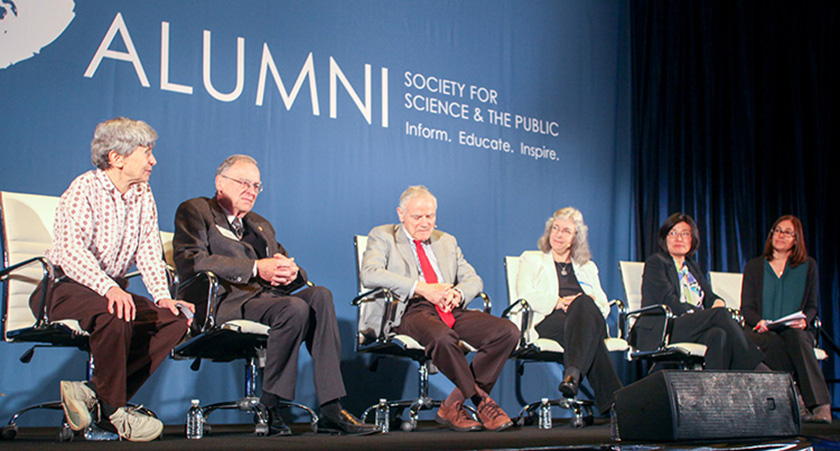‘My STS research is just as important today’

“I think my research from STS is just as important, maybe more, today,” said Marcian “Ted” Hoff.
Ted, a Westinghouse STS 1954 finalist, spoke on a panel about the importance of basic research at the Society’s first ever Alumni Conference on March 16 after the 2016 Intel Science Talent Search (STS), along with several other esteemed peers and former STS competitors.
“We need to research how to deal with carbon dioxide, how to synthesize fuels from it. And water desalination,” Ted said.
But the funding isn’t there, he lamented. “This seems so short-sighted. We need more money for research on what will save the planet.”
Ted, a retired Chief Technologist at Teklicon, worked for several years on government-sponsored research. “Then Intel came along,” he said.
He was the first Intel Fellow and worked on semiconductor memory. His side project ended up becoming the microprocessor. “One of the biggest issues was actually selling the concept to the company that it should be sold as a product,” he said.
He introduced a new era in electronic design, and made the way for the personal computer. Later on, he worked on products for the telephone industry.
Do what you want in science, no matter what anyone says
Getting a job in research early on helped Debra Elmegreen realize, “I can do whatever I want. It doesn’t matter what anyone else says.”
In her generation, women were not allowed to apply for telescope time by themselves. “I was on the new front of women applying [for telescope time],” she said. “I went to Palomar [California] for the biggest telescope at the time, 200 inches, which is small now, and studied galaxy structure.”
Debra, a Westinghouse STS 1971 finalist, studies how stars are born and was the first woman to receive an astrophysics degree from Princeton University. She is a professor of astronomy and serves on the Maria Mitchell Chair at Vassar College.
I think my research from STS is just as important, maybe more, today.
—Ted Hoff
When Sojin Ryu first came to the U.S., to distract her from the troubles she faced as an immigrant, she got very into science. “I was always in the lab,” she said.
Sojin, a Westinghouse STS 1990 finalist, is a professor of stress biology at the University of Mainz, Germany.
“You will have a lot of outside forces telling you you’re not good enough,” Sojin said. “You have to doggedly protect your interests.”
Debra agreed, saying STEM students can’t follow a set road. “There may be many different routes to get there,” she said. The important thing is to get comfortable learning, “because you will be doing that all your life. And keep pace with science and technology.”
Working as a science in academia vs. research outside of universities
In Debra Elmegreen’s generation, women were not allowed to apply for telescope time by themselves.
When she was growing up, Lisa Steiner’s nickname in German meant “but why.” She constantly asked why and how things worked. She is a professor of immunology at MIT and was a Westinghouse STS 1950 finalist.
At Harvard, Lisa was the only woman in her class. In her undergraduate math classes, there were also few women.
She went on to MIT and got a job, despite being told they wouldn’t hire a woman by others in the job market. “It never occurred to me that it would be hard,” she said.
In the department of about 30 people, Lisa was the only female professor. She had young female students come up to her and call her a role model.
“I had never thought of myself as a role model,” Lisa said. “I had just done what I liked, what I was interested in. There was and is a glass ceiling. Things have certainly improved a lot.”
Her nickname meant “but why.”
Lisa found herself in academic medicine. She said it was difficult to deal with clinical medicine because she couldn’t help so many of the desperately ill patients.
Leroy Hood, on the other hand, found the bureaucracy of state universities “utterly stultifying.” He found a marvelous freedom to conduct his research outside of academia.
Leroy, the president and co-founder of the Institute for Systems Biology and a Westinghouse STS 1956 finalist, studied biology and automated DNA sequencing. Over time, he developed six instruments that could read and write DNA. His work helped make the Human Genome Project possible.
He encouraged STEM students to switch careers every 10 years, as a way to remain interested and keep learning.
Leroy also said science is all about the fundamental curiosity that drives us. But it’s also about having fun and remaining excited about what you’re doing.


